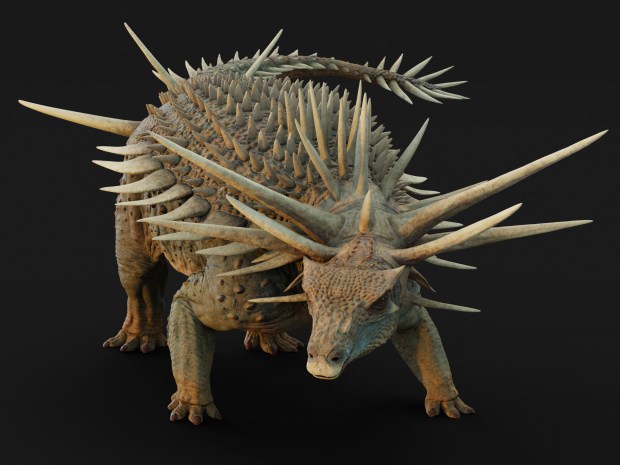Science
Scientists Uncover Unique Spikes of Ancient “Punk Rock” Dinosaur

In a remarkable discovery, scientists have revealed that the ancient dinosaur known as Spicomellus sported metre-long spikes protruding from its neck, likely serving as a defense mechanism against predators. This finding comes from the analysis of fossils that illustrate the dinosaur’s unique and elaborate armor, positioning Spicomellus as one of the most distinctive ankylosaurs ever identified.
The Spicomellus roamed the Earth approximately 165 million years ago and is recognized for its bizarre physical traits. Researchers found bony spikes that were fused to its ribs, a feature not observed in any other vertebrate species, either living or extinct. This analysis builds upon earlier findings, which were based solely on a single rib bone discovered near Boulemane, Morocco, that was purchased by a researcher in 2019.
Insights into Spicomellus’ Armored Evolution
Recent fossil discoveries have revealed that the Spicomellus had spikes measuring up to 87 centimetres extending from a bony collar surrounding its neck. Researchers believe these spikes could have been even longer during the dinosaur’s lifetime, as detailed in the scientific journal Nature.
Professor Richard Butler from the University of Birmingham, who co-led the research team, emphasized the significance of this finding. He stated, “Spicomellus is one of the strangest dinosaurs that we’ve ever discovered. It’s utterly unlike any other found anywhere else in the world.” He added that this discovery is likely to captivate the public’s imagination and shed light on the early evolution of armored dinosaurs.
Co-researcher Professor Susannah Maidment from the Natural History Museum in London echoed Butler’s sentiments, noting that the fossils “are absolutely bizarre” and challenge previous notions about the evolution of these creatures. Originally, there were doubts regarding whether Spicomellus was indeed an ankylosaur, but the new findings confirm this classification.
The Role of Spikes in Defense and Display
The diverse array of armor found on Spicomellus includes not only the long neck spikes but also large spikes projecting upwards over its hips and a variety of blade-like spikes running along its shoulders. Professor Maidment remarked, “We’ve never seen anything like this in any animal before,” suggesting that while the armor likely first evolved for protection, it may have later served other purposes, such as attracting mates or displaying dominance.
The discovery of the Spicomellus species began with the acquisition of that solitary rib bone, leading researchers to uncover the dinosaur’s remarkable features. With each new fossil, scientists continue to expand our understanding of the evolutionary history of ankylosaurs, which were known for their robust, tank-like bodies and club-shaped tails.
The findings surrounding Spicomellus not only highlight the diversity of life during the Jurassic period but also raise intriguing questions about the evolutionary pressures that shaped these unique dinosaurs. As research continues, the insights gained from Spicomellus may offer a deeper understanding of how dinosaurs adapted to their environments over millions of years.
-

 Entertainment1 month ago
Entertainment1 month agoAimee Osbourne Joins Family for Emotional Tribute to Ozzy
-

 Politics1 month ago
Politics1 month agoDanny Healy-Rae Considers Complaint After Altercation with Garda
-

 Top Stories2 weeks ago
Top Stories2 weeks agoIreland Enjoys Summer Heat as Hurricane Erin Approaches Atlantic
-

 World1 month ago
World1 month agoHawaii Commemorates 80 Years Since Hiroshima Bombing with Ceremony
-

 Top Stories1 month ago
Top Stories1 month agoFianna Fáil TDs Urgently Consider Maire Geoghegan-Quinn for Presidency
-

 World1 month ago
World1 month agoGaza Aid Distribution Tragedy: 20 Killed Amid Ongoing Violence
-

 World1 month ago
World1 month agoCouple Convicted of Murdering Two-Year-Old Grandson in Wales
-

 Top Stories2 months ago
Top Stories2 months agoClashes Erupt Between Far-Right Groups and Migrants in Spain
-

 World2 months ago
World2 months agoAristocrat Constance Marten and Partner Convicted of Infant Murder
-

 Top Stories1 month ago
Top Stories1 month agoHistoric Dalkey Pub The Queens Reopens Under New Management
-

 World1 month ago
World1 month agoTrump Defends FBI Deputy Director Amid Epstein Files Controversy
-

 Politics1 month ago
Politics1 month agoTragic Crowd Surge at Gaza Aid Center Claims 20 Lives









